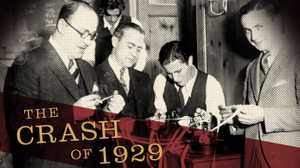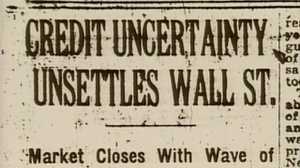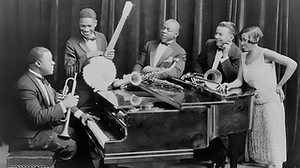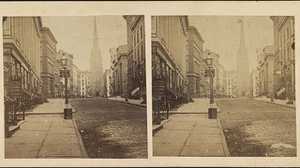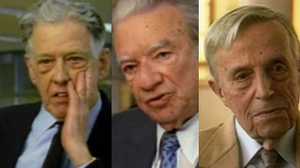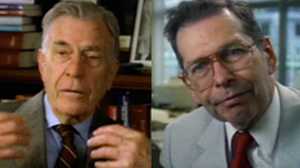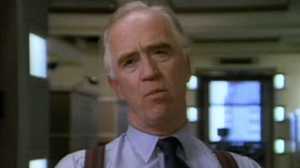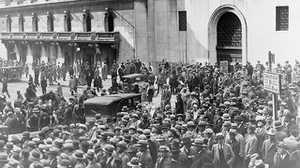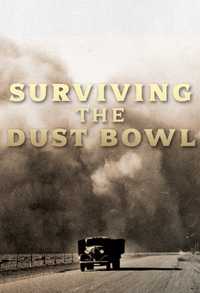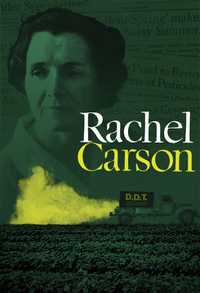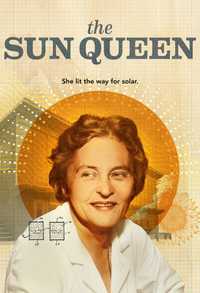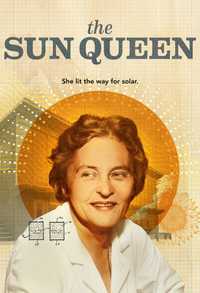Newsreel Announcer (archival): The tremendous crowds which you see gathered outside the stock exchange are due to the greatest crash in the history of the New York Stock Exchange in market prices.
Narrator: December 31st, New Year’s Eve. The crash and its terrible consequences were still in the future. Financial leaders, everyone celebrated what had been a decade of prosperity and boundless optimism. They thought the party would last forever. They called it “The New Era,” 1929. All the hope and promise and illusion of the 20s converged in that one year.
John Kenneth Galbraith, Economist: The United States is afflicted with new eras. Let us not think for a moment that the illusion, the aberration of the 1920s was unique. It is intimately a part of the American character.
Craig Mitchell, Son of Charles E. Mitchell: The mood of the era, I think, can best be remembered by the hit song – was that 1929, Blue Skies?
Rita Mitchell Cushman, Daughter of Charles E. Mitchell: In the 20s, yes, ’28, ’29.
Craig Mitchell, Son of Charles E. Mitchell: How did that go?
Rita Mitchell Cushman, Daughter of Charles E. Mitchell: Smiling at me…
Craig Mitchell, Son of Charles E. Mitchell: Yeah. Nothing but blue skies do I see. Yes.
Rita Mitchell Cushman, Daughter of Charles E. Mitchell: ...Never saw the sun shining so bright, Never saw things going so right. Gray days, all of them gone, nothing but blue skies from now on.
That was the whole tenor of the day. I mean, people believed that everything was going to be great always, always. There was a feeling of optimism in the air that you cannot even describe today.
Rita Mitchell Cushman, Daughter of Charles E. Mitchell: And everyone seemed to have an interest in the stock market. Certainly, the boot black, the tailor, the grocer owned shares of one kind or another.
Narrator: This was the first time that many ordinary Americans had begun to invest in stocks. A stock, a share of a company, is bought and sold here on the floor of the New York Stock Exchange. The stocks themselves have no fixed value. As in an auction, if the stock is in demand, its price goes up. No demand and the price goes down. For almost eight straight years, stock values had been rising. By 1929, there seemed to be no upper limits in this world of paper, numbers and dreams.
Michael Nesbitt, Grandson of Michael J. Meehan: It was an arena of unbounded opportunity where somebody like my grandfather could come into it and make a fortune. So many people made so much money in the market that late in the 20s, it seemed that you just couldn’t go wrong buying stocks in American companies.
Narrator: Here was a whole new way to make a fortune. Unlike the Carnegies and the Rockefellers of previous decades, who built steel mills and dug oil wells, men like Michael Meehan, Jesse Livermore and Charles Mitchell had amassed their fortunes buying and selling stocks, pieces of paper. The public was fascinated. Bankers, brokers and speculators had become celebrities and they lived like royalty.
Rita Mitchell Cushman, Daughter of Charles E. Mitchell: I can hardly believe that a family lived in this kind of house. I mean, today, it would be almost unbelievable. Six stories and these great big rooms.
Craig Mitchell, Son of Charles E. Mitchell: Enormous. We counted it up the other day. We had 16 live-in help in this house —
Rita Mitchell Cushman, Daughter of Charles E. Mitchell: Not counting the chauffeurs and others.
Craig Mitchell, Son of Charles E. Mitchell: — not counting the chauffeurs, yes, aside from all the help we had in the Tuxedo Park house and the Southampton house as well. But those days are gone forever.
Rita Mitchell Cushman, Daughter of Charles E. Mitchell: I should say.
Craig Mitchell, Son of Charles E. Mitchell: But we never thought of it as being grandiose because practically everybody we knew seemed to live in the same way.
Patricia Livermore, Daughter-in-Law of Jesse Livermore: Jesse Livermore had a ticker tape in every home that he owned. They had a beautiful house on 76th Street in Manhattan, on the West side of Central Park. They had a floor at the 813 Fifth Avenue because Dorothy did not like to go to the West Side to change her clothes. So they had a house in Great Neck, they had a summer house in Lake Placid, they had a house in Palm Beach. They had private railroad cars, two yachts. Oh, they lived. They really lived.
Narrator: Few Americans lived like Jesse Livermore, but there was a rising expectation that everyone could have a piece of this prosperity. During his presidential campaign of 1928, candidate Herbert Hoover would make this extraordinary promise.
Herbert Hover (archival): Given a chance to go forward with the policies of the last eight years, we shall soon, with the help of God, be in sight of the day when poverty will be banished from this nation.
Robert Sobel, Historian: There was great hope. America came out of World War I with the economy intact. We were the only strong country in the world. The dollar was king. We had a very popular president in the middle of the decade, Calvin Coolidge, and an even more popular one elected in 1928, Herbert Hoover. So things looked pretty good.
Narrator: The economy was changing in this new America. It was the dawn of the consumer revolution. New inventions, mass marketing, factories turning out amazing products like radios, rayon, air conditioners, underarm deodorant.
Robert Sobel, Historian: This is a period in which the American household gets the washing machine, gets a refrigerator, goes off gaslight and gets electricity in some cities. This is period in which people would buy little plugs to put into the outlets in the wall so the electricity wouldn’t leak on the floor. “What will they think of next,” was a 1920s saying, 'cause new things were continually coming out and they were new things which you could enjoy, not just for the few.
Narrator: One of the most wondrous inventions of the age was consumer credit. Before 1920, the average worker couldn’t borrow money. By 1929, “buy now, pay later” had become a way of life.
Robert Sobel, Historian: So there were changes, many changes in the way people viewed the world and all of them optimistic. You extrapolate the curve and what do you have? Permanent prosperity. That was the term one heard in the late 1920s. “We’re into the age of permanent prosperity.”
Narrator: Wall Street got the credit for this prosperity and Wall Street was dominated by just a small group of wealthy men. Rarely in the history of this nation had so much raw power been concentrated in the hands of a few businessmen, men like William C. Durant.
Aristo Scrobogna, Secretary to William C. Durant: It’s almost impossible to realize the power and the significance of the man. In Flint — when Mr. Durant came to Flint occasionally, people used to say, “Durant is in town.” Just like that, you know, “Durant is in town.” He was bigger than life.
Narrator: Earlier in the century, Durant had founded General Motors. Now, he made his money on Wall Street. Backed by Midwestern auto industrialists, he controlled so much money that he could singlehandedly drive up the price of a stock and then sell, reaping huge profits.
Aristo Scrobogna, Secretary to William C. Durant: He was just at the apotheosis, at the maximum of his power. He managed — according to the voices of the time, according to what was said — anywhere between two to five billion dollars, which in those days was a fabulous — the market was filled with bulls and he was the bull of the bulls.
Narrator: Durant came to Wall Street as one of the titans of industry. Jesse Livermore, whose fortune was estimated at over $100 million, never did anything in his life but play the market.
Robert Sobel, Historian: Everything Jesse Livermore touched turned to gold, it seemed. All he had to do was to press a button and a stock would go up ten points. And that meant, of course, that Jesse Livermore would make a lot of money. So the average American would look at this say, “Gee, if only I knew what he doing, I could make money, too. How do you get in on Jesse Livermore’s brains?”
Narrator: Livermore was a speculator, pure and simple. He didn’t study the health of a company. He didn’t care whether it made a profit or paid a dividend. For him, the stock market was an abstract game of numbers.
Patricia Livermore, Daughter-in-Law of Jesse Livermore: Money was not the end for this man at all. Money was a very peripheral thing for him, but beating the odds, winning a game. That was his objective. He was a numbers man. He lived by the numbers, took an elevator by the numbers. He came into town by the numbers. Everything was done by numbers. When he left his house in the morning, he did not leave at 8:10, he left at 8:07. All of the policemen knew, because of his time schedule, that he would be going down Fifth Avenue, let’s say, at 8:37. Well, of course, traffic lights were hand-operated then, had policemen on boxes. So the instant that they saw his car, the lights were green. He never stopped for a red light.
Narrator: The success of large speculators like Livermore and Durant lured smaller investors to Wall Street, but Charles Mitchell, president of National City Bank, virtually invented the idea of mass-marketing stocks and bonds to the general public. This was a totally new idea and a huge success.
Craig Mitchell, Son of Charles E. Mitchell: The bank, prior to father’s being elected president in 1921, was geared mainly to doing business with large corporations. Father pointed the bank, for the first time, in the direction of going after the little man and
Rita Mitchell Cushman, Daughter of Charles E. Mitchell: Don’t call him the little man. It was Everyman.
Craig Mitchell, Son of Charles E. Mitchell: Well, jedermann (everyman), all right. How old was he then? Thirty-eight years old. And the National City Company had four offices. And then, within three years, there were over 50 offices and by 1929, it was the largest distributor of securities in the world.
Narrator: Even at the height of the speculative frenzy, only a small percentage of the American public actually invested in stocks, but the market had entered popular culture. Wall Street became Main Street. Everyone was talking stocks. Watching the ticker became a national sport. Popular magazines covered financial news. Dozens of best-sellers promised investors the inside track. The characters in the popular comic strip “Gasoline Alley,” were investing in a company called “Rubber Keyhole.” Stock tips came from everywhere. Some investors followed the advice of Evangeline Adams, an astrologer.
Manly P. Hall, Founder, Philosophical Research Society: She was able to calculate the variations of the stock exchange so accurately that there was practically no difference to having have read it in a ledger somewhere. Among her more interesting clients were Charles Chaplin, Mary Pickford and J. Pierpont Morgan.
Narrator: In February, Evangeline Adams looked at the stars and predicted a dramatic upswing in stock prices for the coming months. The stock market, once considered a highly risky place to put your money, was now beginning to attract a whole new group of amateur speculators. Among the new players was one Julius Marx. Everyone knew him by his stage name, Groucho.
Arthur Marx, Son of Groucho Marx: But they were poor and it always affected my father 'cause he was always kind of thrifty and worried about his future and what would become of him when no one else wanted him as an actor anymore. So he was always saving money, turning off the lights and turning off the water around the house even after he was in Hollywood and making a lot of money.
Narrator: Of all the Marx brothers, Groucho was the most financially conservative. In 1929, he took his life’s savings and put it in a sure thing, the stock market.
Arthur Marx, Son of Groucho Marx: He was always phoning a broker and getting hot tips and wanting to know what the stocks were that — how they were doing. And if he wasn’t on the phone, he would take me into Great Neck, which was a little village at the time but they did have a stockbroker called Newman Brothers & Worms and all these men who were investing in the market, they’d all sit there in chairs like a little theater and watch the ticker tape go by.
Narrator: Groucho, along with record numbers of smaller investors, was borrowing money to buy stocks. It was called “buying on margin.” You only needed ten percent down. Just $1,000 would get you $10,000 worth of stock. Suddenly, you were in the same league with the big players or so it seemed. But the stock market was not a level playing field.
Patricia Livermore, Daughter-in-Law of Jesse Livermore: In the 20s and 30s, one of the big features of the stock market is the fact that it wasn’t controlled and that operators could do a lot of things that are not permitted today.
Narrator: One of the most common tactics was to manipulate the price of a particular stock, a stock like Radio Corporation of America.
Michael Nesbitt, Grandson of Michael J. Meehan: RCA was, in the 20s, what Xerox was in the 60s, what was a great growth stock. The stock went from — I can’t remember the exact numbers, but from something like 20 to 400, split many times and made many people, including my grandfather, very wealthy. It was one of the stocks that was manipulated by a pool.
Narrator: Wealthy investors would pool their money in a secret agreement to buy a stock, inflate its price and then sell it to an unsuspecting public. Most stocks in the 1920s were regularly manipulated by insiders like RCA specialist Michael Meehan.
Michael Nesbitt, Grandson of Michael J. Meehan: In those days, that was legal and it was quite common practice for a group of Wall Streeters to take a stock in hand. And they would acquire a position in the stock early on and then, they would see to it that there was good press on the stock, a lot of publicity.
Robert Sobel, Historian: I would say that practically all the financial journals were on the take. This includes reporters for The Wall Street Journal, The New York Times, The Herald-Tribune, you name it. So if you were a pool operator, you’d call your friend at The Times and say, “Look, Charlie, there’s an envelope waiting for you here and we think that perhaps you should write something nice about RCA.” And Charlie would write something nice about RCA. A publicity man called A. Newton Plummer had canceled checks from practically every major journalist in New York City.
Michael Nesbitt, Grandson of Michael J. Meehan: Then, they would begin to — what was called “painting the tape” and they would make the stock look exciting. They would trade among themselves and you’d see these big prints on RCA and people will say, “Oh, it looks as though that stock is being accumulated."
Robert Sobel, Historian: Now, if they are behind it, you want to join them, so you go out and you buy stock also. Now, what’s happening is the stock goes from 10 to 15 to 20 and now, it’s at 20 and you start buying, other people start buying at 30, 40. The original group, the pool, they’ve stopped buying. They’re selling you the stock. It’s now 50 and they’re out of it. And what happens, of course, is the stock collapses.
Narrator: On March 8, 1929, Michael Meehan began one of the most successful pools on Wall Street. From the 8th to the 17th, Meehan and the pool pushed up the value of RCA almost 50 percent. On March 18th, they sold and divided up their profits. In today’s money, they had made $100 million for one week’s work.
Michael Nesbitt, Grandson of Michael J. Meehan: The pools were a little like musical chairs. When the music stopped, somebody owned the stocks and those were the sufferers.
Narrator: If small investors suffered, they would soon be back for more. They knew the game was rigged, but maybe next time, they could beat the system. Wall Street had its critics, among them economist Roger Babson. He questioned the boom and was accused of lack of patriotism, of selling America short.
John Kenneth Galbraith, Economist: Roger Babson warned of the speculation and said, “There’s going to be a crash and the aftermath is going to be quite terrible.” And people jumped on Babson from all around for saying such a thing, so that people who were cautious about their personal reputation, who did not want to call down on themselves a lot of calumny, kept quiet.
Narrator: Mobster Al Capone was not a cautious man. From his Chicago headquarters, he condemned the wild speculation on Wall Street. “It’s a racket,” he said, “Those stock market guys are crooked.” Capone invested his money in a $100-million bootleg liquor business. Business was good. On Valentine’s Day, 1929, he had just eliminated the competition.
March 4th, Inauguration Day. Republican President Calvin Coolidge had run his administration on the belief that business was the basis of America’s prosperity. Government should not interfere. Herbert Hoover had won a landslide victory, promising to carry on the tradition.
John Kenneth Galbraith, Economist: This was a time in our history when governments did not, as now, take responsibility for the economy. They presided over it, but the level of economic activity and the level of economic growth and the stability of prices were not yet everyday concerns of the president. And what Coolidge did was to say how wonderful times were, how happy everybody was going to be and how prosperous everyone was going to be. And Hoover’s responsibility was to continue that optimism.
Narrator: Politicians came and went, but in the 20s, the businessman was king. New York City had a dapper, corrupt and vastly popular mayor, Jimmy Walker, but behind the scenes were powerful financial leaders like Charles Mitchell.
Craig Mitchell, Son of Charles E. Mitchell: Jimmy Walker was high, wide and fancy with the city finances. One day, Father called Mayor Walker up here and he had some other bankers with him. And Mayor Walker was sort of put on the grill in the upstairs library, while these bankers read the riot act to him to try and get some fiscal responsibility instilled into him. And I know that after the meeting, somebody took me into the library and pointed me out the chair that the mayor had been sitting in and he’d been so nervous — what were those, Louis XIV chairs with all the little —
Rita Mitchell Cushman, Daughter of Charles E. Mitchell: Louis XV.
Craig Mitchell, Son of Charles E. Mitchell: Louis XV chairs with all the little tacks in there, the brass tacks.
Rita Mitchell Cushman, Daughter of Charles E. Mitchell: Yes.
Craig Mitchell, Son of Charles E. Mitchell: And he’d pulled out almost all the brass tacks — they were sitting on the floor — out of sheer nerves.
Narrator: The stock market, too, was getting a severe case of nerves. On Friday, March 22nd, all eyes were on that august government body in Washington, the Federal Reserve Board. The board distrusted the boom. They saw the speculation as reckless and dangerous because it was based more and more on the shaky foundation of borrowed money, margin. The board had the power to curb the borrowing, the market was now dependent on borrowed money. Without margin, it would collapse. The board met day after day. Would they ask for regulation of the stock market? They issued no public statements. Their silence was terrifying.
On Monday, March 21st, investors began to sell. Blue chip stocks plunged. Tuesday, another wave of selling swept the market. As it fell, people holding stock on margin were hit hard. They’d put only ten percent down, but the value of their stock dropped more than 10 percent, so their down payment was gone. To hold their stocks, they’d have to put up more money. On March 26th, millions of investors suddenly found themselves in deep trouble.
Robert Sobel, Historian: Your broker would call you and say, “We need more money. You’re wiped out.” Unless you could give him more money, he would then sell the stock. Now, he would sell the stock, which would cause the stock to go down to 85, 86 and now, more margin calls are triggered. So one margin call triggers another margin call, triggers another margin call and it goes all the way down.
Narrator: With everyone trying to borrow money to cover the falling value of their stocks, there was a credit crunch. Interest rates soared. At 20 percent, few people could afford to borrow more money. The boom was about to collapse like a house of cards.
Charlie Mitchell was horrified. His success, his entire career, his personal fortune had been based on a rising market. If nobody else was going to stop the crash, Charles Mitchell would.
Craig Mitchell, Son of Charles E. Mitchell: Father, at that point, stepped in and announced that the National City Bank would provide $25 million of credit, which was all very well and very necessary, but he added the fateful words, “whatever the Federal Reserve Board thinks.” And Senator Carter Glass, who had been sort of the father of the Federal Reserve Act in 1913, took that as a direct slap across the face. But whatever Senator Glass thought, immediately, the credit crisis was alleviated. In fact, within the next 24 hours, call money went from 20 percent to eight percent and that stopped the panic, then, in March.
Narrator: The next day, the market rallied. The Federal Reserve Board remained silent, tacitly accepting defeat. The hero of the day was Charlie Mitchell. He had singlehandedly stopped the crash of ’29. With the start of the baseball season, people quickly forgot the break in the market.
New events filled the papers. There was a crisis in Nicaragua, where the nationalist hero, Augusto Sandino, was threatening American marines; tragedy in the British Mandate of Palestine as Jews and Arabs clashed over control of holy sites in Jerusalem. And in Antarctica, Commander Byrd was at his base camp, Little America, waiting for a break in the weather. His elaborately-planned flight over the South Pole was still on ice.
The newsreels had come into their own. Now, in living sound, patrons could keep abreast of the important events of the day.
Woman (archival): The biggest news of the day is not the Naval agreement, not even Prohibition, but the return of the natural waistline.
Patricia Livermore, Daughter-in-Law of Jesse Livermore: Dorothy Livermore was a typical flapper. She has to embody the 20s. She would do almost anything on an impulse. She had some priceless pieces of 18th-century furniture, but the house had settled and the floors were not level. But Mrs. Livermore didn’t like to spend money that didn’t show, so instead of having the hoist put underneath, she simply solved the problem by having the legs of the furniture cut off to fit the sloping floors, so that the tops of all of the furniture were level, but of course, the legs were on different angles. And this was her typical solution. As long as the tops were level, everything was fine.
Narrator: Everything was not fine that spring with the American economy. It was showing ominous signs of trouble. Steel production was declining. The construction industry was sluggish. Car sales dropped. Customers were getting harder to find. And because of easy credit, many people were deeply in debt. Large sections of the population were poor and getting poorer.
Just as Wall Street had reflected a steady growth in the economy throughout most of the 20s, it would seem that now the market should reflect the economic slowdown. Instead, it soared to record heights. Stock prices no longer had anything to do with company profits, the economy or anything else. The speculative boom had acquired a momentum of its own.
John Kenneth Galbraith, Economist: It was this nature of mass illusion. Prices were going up, people bought. That forced prices up further, that brought in more people. And eventually, the process becomes self-perpetuating. Every increase brings in more people convinced of their God-given right to get rich.
Narrator: The 20s was a decade of all sorts of fast money schemes. Three years earlier, everyone was buying Florida real estate. As prices of land skyrocketed, more people jumped in, hoping to make a killing. Then, overnight, the boom turned to bust and investors lost everything.
Groucho Marx (Film, The Cocoanuts): Florida, folks. Sunshine, sunshine. Perpetual sunshine all the year around. Let’s get the auction started before we get a tornado. Right this way. Step forward, everybody.
Narrator: In May, the Marx Brothers were before the cameras with their first film, The Cocoanuts. Its subject? The Florida land boom. Now, in 1929, the gullibility of those naive speculators was something to laugh about.
Groucho Marx (Film, The Cocoanuts): Eight hundred wonderful residences will be built right here. Why, they’re as good up, better. You can have any kind of a home you want to. You can get even get stucco. Oh, how you can get stucco. Now is the time to buy while the new boom is on. Remember that old saying, “A new boom sweeps clean.” And don’t forget the guarantee.
Narrator: Groucho Marx would film these scenes and then rush to his broker to put more of his savings into the booming market, on margin, of course.
Arthur Marx, Son of Groucho Marx: Max Gordon, a Broadway producer, was also heavily in the market and Gordon could never get over the fact that the market was going up and up and up all the time. And he said to my father, “How long has this been going on, Groucho?” And my father said, “I don’t know, but my broker down in Great Neck tells me that it’s because there’s a worldwide market for American goods and it’s never going to go down, that the market’ll just keep going up and up and up.”
Narrator: May 1929. Stock prices were going up and up. With so much money to be made, people were borrowing more money than ever before to buy stocks. Market leaders like William Durant, far from being worried, were ecstatic. Off on his annual visit to Europe, he announced that everything would be fine as long as we all continued to believe: “Confidence — not halfway confidence, but 100-percent confidence — is the real basis for our prosperity.”
Astrologer Evangeline Adams was now putting out a newsletter. Her 100,000 subscribers learned how the Zodiac could influence stock prices. Her advice for the coming summer: buy.
Ben Karol, Former Newspaper Delivery Boy: They thought this was a ride that was never going to end, just goes on and on and on and every day, they got more money and they’re counting up their paper profits. And they’re selling and buying and buying and selling and they’re doing great.
Tom McCormick, Former Stock Sales Clerk: Geez, I’d go to get a shoeshine and they’d say, “How’s the market?” You’d go to the barber to get a haircut, “How is the market?” Everybody was in the market.
Robert Sobel, Historian: There were people who were looking for the one lucky break, people who were just hoping that they’d strike it right, you know. You take a rifle and you aim it at the ocean and you hope to hit a fish.
Narrator: Along with the market, temperatures soared that summer. It was a record heat wave and a record three months at the Exchange. Some stocks doubled in value. In June, The New York Timesindex of stocks rose 52 points. In July, another 25.
In the middle of the summer, the Graf Zeppelin was completing its first leisurely trip around the world. The Marx Brothers had finished shooting their film, The Cocoanuts. Commander Byrd was still at his base camp near the South Pole. He, too, had money in the market and radioed his broker for the latest quotes. Back in Cleveland, George Herman Ruth hit his 500th home run and on the radio, they were playing the latest hit tune, "I’m in the Market for You." On August 17th, Michael Meehan’s brokerage firm launched a new service.
Michael Nesbitt, Grandson of Michael J. Meehan: One of my grandfather’s innovations was putting brokerage houses on the ocean liners — the first one on the Berengaria — and that allowed you during the — whatever it was, during the six- or seven-day passage to Europe, if you were such a stock market addict that you couldn’t stand the withdrawal for that period, you could walk into the office and place your order to buy or sell 100 shares of General Motors or General Electric or whatever. And they would radio that order back to New York. It was being very modern at the time. They were very wealthy people on the trans-Atlantic liners and it gave them something to do.
Narrator: At sea and on land, everyone seemed to be making money. It was a stampede of buying. And major speculators like John Jacob Rascob whipped up the frenzy. He told readers of The Ladies’ Home Journal that now everyone could be rich.
September 2nd, Labor Day. It was the hottest day of the year. The markets were closed and people were at the beach. A reporter checked in with astrologer Evangeline to ask about the future of stock prices. Her answer: the Dow Jones could climb to heaven. The very next day, September 3rd, the stock market hit its all-time high.
Ben Karol, Former Newspaper Delivery Boy: My father and I had an ongoing discussion about the stock market. And I used to say, “Pop, everybody’s getting rich but you. You know, you work so hard and you’re never going to make a nickel. All you do is you keep delivering these newspapers and that’s about it. The guy who’s shining shoes is in the stock market, the grocery clerk is in the stock market, the school teacher’s in the stock market. The teller at the bank is in the stock market. Everybody’s in the stock market. You’re the only one that’s not in the stock market.” And he used to sit and laugh and say, “You’ll see. You’ll see. You’ll see.”
Narrator: On September 5th, economist Roger Babson gave a speech to a group of businessmen. “Sooner or later, a crash is coming and it may be terrific.” He’d been saying the same thing for two years, but now, for some reason, investors were listening. The market took a severe dip. They called it the “Babson Break.” The next day, prices stabilized, but several days later, they began to drift lower. Though investors had no way of knowing it, the collapse had already begun.
In the weeks to follow, the market fluctuated wildly up and down. On September 12th, prices dropped ten percent. They dipped sharply again in the 20s. Stock markets around the world were falling, too. Then, on September 25th, the market suddenly rallied.
Reuben L. Cain, Former Stock Salesman: I remember well that I thought, “Why is this doing this?” And then I thought, “Well, I’m new here and these people” — like every day in the paper, Charlie Mitchell would have something to say, the J.P. Morgan people would have something to say about how good things were — and I thought, “Well, they know a lot more about this market than I do. I’m fairly new here and I really can’t see why it’s going up.” But then, when they say it can’t go down or if it does go down today, it’ll go back tomorrow, you think, “Well, they really are like God. They know it all and it must be the way it’s going because they say so.”
Narrator: As the market floundered, financial leaders were as optimistic as ever, more so. Just five days before the crash, Thomas Lamont, acting head of the highly conservative Morgan Bank, wrote a letter to President Hoover. “The future appears brilliant. Our securities are the most desirable in the world.” Charles Mitchell assured nervous investors that things had never been better.
Craig Mitchell, Son of Charles E. Mitchell: Practically every business leader in America, and banker, right around the time of 1929, was saying how wonderful things were and the economy had only one way to go and that was up.
Rita Mitchell Cushman, Daughter of Charles E. Mitchell: Unfortunately, he didn’t have a crystal ball to predict the future.
Robert Sobel, Historian: There’s an old saying on Wall Street that the two most important emotions are fear and greed and you go from fear to greed in about a fraction of a second. So you’re very, very greedy and you say to yourself, “I want to make more.” And then, the market goes down ten points and you get frightened. “I want to keep what I have,” so you sell everything. And that’s how you have a panic. So you can panic on the upside — people rushing in to get in before the train takes off — and a panic on the downside, trying to get off the train before disaster hits.
Narrator: Monday, October 21st. Hoover, along with the political and financial leaders of the country, arrives in Dearborn, Michigan to celebrate the 50th anniversary of Edison’s invention of the light bulb. The host is Henry Ford. The country is reminded that in 50 short years, men like Ford, Durant and Edison had transformed America from a third-rate power into the industrial giant of the world. And while they celebrated, their world was beginning to fall apart.
John Kenneth Galbraith, Economist: There came a Wednesday, October 23rd, when the market was a little shaky, weak. And whether this caused some spread of pessimism, one doesn’t know. It certainly led a lot of people to think they should get out. And so, Thursday, October the 24th — the first Black Thursday — the market, beginning in the morning, took a terrific tumble.
Craig Mitchell, Son of Charles E. Mitchell: The market opened in an absolutely free fall and some people couldn’t even get any bids for their shares and it was wild panic. And an ugly crowd gathered outside the stock exchange and it was described as making weird and threatening noises. It was, indeed, one of the worst days that had ever been seen down there.
Narrator: There was a glimmer of hope on Black Thursday. Directly across from the New York Stock Exchange was a low, stately building, the House of Morgan. Twenty-two years earlier, J. Pierpont Morgan had stopped the panic of 1907. October 24th, high noon. All eyes were now on acting head, Thomas W. Lamont.
Edward Lamont, Grandson of Thomas W. Lamont: Tom Lamont called a number of the other bankers, like Charles Mitchell of the National City Bank and people from the Bankers Trust and J. Albert Wiggin of the Chase Bank and so forth — there were about a half a dozen of them there — and they were gathered together to really discuss what they could do to stem this tremendous onslaught of selling stocks on the stock exchange that was taking place.
Craig Mitchell, Son of Charles E. Mitchell: About 12:30, there was an announcement that this group of bankers would make available a very substantial sum to ease the credit stringency and support the market. And right after that, Dick Whitney made his famous walk across the floor of the New York Stock Exchange.
Narrator: Richard Whitney, vice president of the Exchange, was chosen by the bankers to be their representative. At 1:30 in the afternoon, at the height of the panic, he strolled across the floor and in a loud, clear voice, ordered 10,000 shares of U.S. Steel at a price considerably higher than the last bid. He then went from post to post, shouting buy orders for key stocks.
Horace Silverstone, Former New York Stock Exchange telephone clerk: He stood up on one of the seats at the post and he said, “I give 45 for 50,000 Standard Oil,” and everybody started to applaud. “Oh, the crash is over. If Morgan’s putting his money in, then maybe the crash is over.”
John Kenneth Galbraith, Economist: And sure enough, this seemed to be evidence that the bankers had moved in to end the panic. And they did end it for that day. The market then stabilized and even went up.
Edward Lamont, Grandson of Thomas W. Lamont: The New York Times said that thanks to the formation of this bankers pool, most observers felt that the panic and the great sell-off was over. And most people did feel that way. Tom Lamont felt that way.
John Kenneth Galbraith, Economist: But Monday was not good. Apparently, people had thought about things over the weekend, over Sunday, and decided maybe they might be safer to get out. And then came the real crash, which was on Tuesday, when the market went down and down and down, without seeming limit.
Narrator: October 29th. Morgan’s bankers could no longer stem the tide. It was like trying to stop Niagara Falls. Everyone wanted to sell. AT&T down 50 percent. RCA, once $110 a share, couldn’t find buyers at $26. Blue Ridge 100 plunged to $3 and still no buyers. On the floor, they had never seen anything like it.
Horace Silverstone, Former New York Stock Exchange telephone clerk: And it was just like a nightmare and I couldn’t believe what was going on here. In those days, every buy order was on a black pad and every sell order was on a red pad. And all I saw was members running around with fistful of red orders.
Tom McCormick, Former Stock Sales Clerk: Just chickens with their head cut off, they didn’t know which way to run. They were panicking, screaming. Everybody was bumping into everybody else.
Horace Silverstone, Former New York Stock Exchange telephone clerk: Don’t remind him. Anyhow, this is what happened and I tell you — and I was supposed to answer everybody yelling at me — I said, “What am I supposed to do?” I mean, nobody knew what the hell to do.
Narrator: William Durant, the bull of the bulls, now tried singlehandedly to support the market. The further it plunged, the more of his millions he poured into it.
Aristo Scrobogna, Secretary to William C. Durant: He became truly convinced that he was omnipotent. He thought that nothing could really unseat him. It was unfortunate. The forces were too great. There was no one man that could have been so powerful to control the market.
Narrator: There were some people, however, whose investment strategies made money. On October 29th, Jesse Livermore’s wife, hearing of the crash, ordered the servants to move all the furniture out of their mansion into a small cottage on the estate.
Patricia Livermore, Daughter-in-Law of Jesse Livermore: So when Mr. Livermore got home that night, he walked into a totally vacant house. When she told him that she had effected the move because she was sure that they had lost all their money, he told her that he had made more money that day than he had ever made before.
Narrator: For most others, it was all over. In brokers’ offices across the country, the small investors — the tailors, the grocers, the secretaries — stared at the moving ticker in numb silence. Hope of an easy retirement, the new home, their children’s education, everything was gone.
Arthur Marx, Son of Groucho Marx: My father was ready to kill himself. In the morning of the crash, he got a call and it was Max Gordon and Max Gordon says, “Groucho?” and my father said, “What?” And Gordon said, “Groucho, the jig is up.”
Reuben L. Cain, Former Stock Salesman: There were all sorts of rumors and you’d see people going down the street looking up to see if they could catch somebody jumping out the window. Now, it turned out there weren’t as many people who jumped out the window as they reported, but some did and others committed suicide other ways.
Narrator: Five hundred miles from Wall Street in the Atlantic, the luxury liner, the Berengaria, was heading home. From Michael Meehan’s brokerage office, word spread through the ship: “The bottom’s fallen out of the market.” Men came running out of their Turkish baths in towels. Card games ended abruptly. Everyone tried to jam into the tiny office, yelling, “Sell at market!” They had left England wealthy men. They docked in New York without a penny.
John Kenneth Galbraith, Economist: There’s nothing unique about this. It is something which happens every 20 or 30 years because that is about the length of the financial memory. It’s about the length of time that it requires for a new set of suckers, if you will, a new set of people capable of wonderful self-delusion to come in and imagine that they have a new and wonderful fix on the future.
Narrator: In the 1930s, Charles Mitchell was hounded by Senate committees and the IRS. The crash had left him $12 million in debt.
Rita Mitchell Cushman, Daughter of Charles E. Mitchell: This house was taken over, of course, and things changed. And I began to know what the real world was all about. It was about time. I was 19 years old.
Narrator: Mitchell made a remarkable comeback. He paid off his debts and died in 1955, a highly-respected figure on Wall Street. In 1936, William Durant filed for bankruptcy. His only assets, which he valued at $250, were the clothes on his back. In the late 30s, the founder of General Motors tried his hand at everything from running a bowling alley to selling a cure for dandruff. He died in 1947, still talking about making a comeback.
Herbert Hoover spent much of the early 1930s fishing. He explained in a speech that fishing is a constant reminder of humility and of human frailty, “for all men are equal before fishes.”
Patricia Livermore, Daughter-in-Law of Jesse Livermore: The game on Wall Street had changed a great deal for Livermore and the SEC was becoming a powerful factor and the rules were changed. He couldn’t operate freely, buy and sell the way he had in the past and he couldn’t adapt to the new regulations. So, in a sense, his playing with the market was over and I think a great deal of his interest in life was over at that point. The game was gone.
Narrator: In 1940, the day before Thanksgiving, a photographer snapped this photograph of an old and very tired Jesse Livermore. Several hours later, Livermore would go into a men’s washroom and put a bullet through his head.
At the end of 1929, as they celebrated New Year’s Eve, all that lay in the future. Nobody knew that the Great Depression was coming — unemployment, bread lines, bank failures — this was unimaginable. But the bubble had burst. Gone was that innocent optimism, the confidence, the illusion of wealth without work. One era had ended. They toasted the coming of the 30s, but somewhere, deep down, they knew the party was over.
